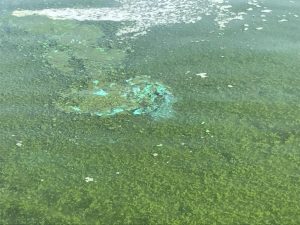Excessive heat and pollutants make Snake River, southern Idaho reservoirs, and North Idaho lakes hazardous for swimming
Each summer, warm water combined with excess phosphorus and nitrogen contribute to dangerous conditions in Idaho lakes and reservoirs, when contact with toxic algae can cause illness or death in people, pets, wildlife, and livestock. According to the Idaho Department of Health and Welfare, at least 7 Idaho water bodies are currently unsafe, with tests pending on other lakes around the state.
Along the Snake River, both Brownlee and Hells Canyon Reservoirs are experiencing toxic algae outbreaks, as well as Cedar Creek and Salmon Falls Reservoirs near Twin Falls. In North Idaho, outbreaks have been confirmed on Fernan, Avondale, and Hayden Lakes. Because several of these water bodies provide drinking water sources, it’s especially concerning.
Why do outbreaks seem more common?
Toxic algae outbreaks are exacerbated by heat waves that contribute to warm water, along with reduced flows. Record heat in July 2024, combined with excess nitrogen and phosphorus in the water have resulted in dangerous conditions across Idaho that threaten people, wildlife, and livestock, and harm recreation-dependent economies. But it’s not just 2024 that was hot. According to climate experts, the last 10 years between 2014-2023 have been the hottest 10 years ever, and that heat contributes to dozens of dangerous outbreaks in Idaho each year.
While it’s difficult to control the temperature, one factor that we CAN control is excess pollution, primarily phosphorus and nitrogen.
While critical for life on earth, too much nitrogen and phosphorus is a bad thing for water quality, because it stimulates algal growth. Pollution sources include agricultural runoff, waste from beef and dairy feedlots, leaking septic systems, and excess fertilizers on fields, lawns, and golf courses. To have any hope of reducing the number of toxic algae outbreaks we see every year in Idaho, we must take necessary steps to reduce nitrogen and phosphorus pollution in our waters.

Critical need for monitoring and funding
In addition to addressing the root causes of toxic algae, we also need to ensure that the state agencies entrusted with environmental protection and human health have the resources they need to identify and respond to outbreaks when they inevitably occur.
Every year, we see outbreaks in Fernan Lake in the north, Cascade Lake in the south, Henrys Lake in the east, and Brownlee Reservoir along the Oregon border, yet there is no regular or proactive monitoring on these water bodies. The lack of comprehensive monitoring for toxic algae is largely due to the lack of dedicated funding to tackle this public health hazard head-on and protect people, pets, livestock, fish, and wildlife.
Join us in advocating for sufficient dedicated funding to proactively monitor, manage, and prevent toxic algae outbreaks! Together, we are calling on the Governor’s Office and the Idaho Department of Environmental Quality to ensure funding is made available to address this public health hazard and to take meaningful steps toward protecting people, pets, and livestock from toxic algae. Proactive monitoring will allow the state to identify toxic algae outbreaks and allow the Idaho Department of Health & Welfare to promptly issue health advisories when outbreaks are confirmed.
This kind of dedicated toxic program is not unprecedented; our neighbors in Utah have a robust program that is supported by $200,000 in annual appropriations from their state legislature. Why can’t Idaho’s legislature do the same?
What you can do!
While we appreciate the efforts by state agencies and local public health districts, more needs to be done. Currently, no state or local agencies receive any dedicated funding to work on toxic algae issues, monitoring, or notification.
Based on threats to public and environmental health, Governor Little and the Idaho Legislature should allocate dedicated funding to the Idaho Departments of Environmental Quality and Health & Welfare to proactively monitor for toxic algae, ensure a robust notification process, and increase education and prevention of toxic algae.
Take action below and let Idaho leaders know that you want funding allocated toward this public health hazard. After all, we all benefit from clean water!

